As an Amazon Associate, we earn from qualifying purchases with no additional costs for you.
Knife care and maintenance do not only involve honing and sharpening your knives but also how they are kept when not in use. Proper storing and organizing of your knives will keep them in good condition, keep them sharper for longer, and are ready to use at any time!
Correct storage of your kitchen knives is as important as keeping them sharp and honed. Incorrect storage can result in a dull, damaged knife edge, reducing the lifespan of the knife. Proper knife storage should protect the knife from damage, corrosion, or accidentally cutting someone.
Storing and organizing your kitchen knives is a crucial aspect of knife care and should receive as much attention as cleaning and sharpening your knives. There are right ways and wrong, potentially damaging ways to store your knives. We will give you some guidance and some tips and hacks to protect and store your knives!
If you are interested in checking out the best magnetic knife holders for walls and the knife organizers you can find them by clicking here and here (Amazon links).

Why Is It Important To Store Knives Correctly?
Most people know the importance of the correct use and care of a knife when it is being used, but why is the correct storage of a knife so important?
Improper storage of your knives can dull the edge or, even worse, damage the edge of the knife, causing significant damage that will need to be repaired.
Dull knives need to be sharpened before they are effective and safe to use, so an incorrectly stored knife will require more frequent sharpening, effectively shortening the life of the knife.
Knives with a damaged edge can be expensive to repair, and in some cases, the damage can be enough to ruin the knife beyond repair!
High-quality knives are expensive, making it important to protect your knives and get the most out of your investment!
Incorrectly stored knives can also be damaged by corrosion, such as rust, if the method of storing the knives does not offer sufficient protection for the blade.
Safety is another consideration for proper storage of your knives. A sharp knife can inflict serious injury on the unwary, and the risk is increased if the knife is not stored safely and securely.
Many people store their knives in a kitchen drawer, which is dangerous if the knife edge is unprotected. The sharp edge could cut people reaching into the draw to retrieve other utensils.
It is especially important to secure sharp knives if your children have access to your kitchen drawers, as they may get seriously injured by unprotected knives.
The risk of damage to your knives, dulling of the edge, prevention of corrosion, and the safety of people in the home can all be addressed by the proper storage of your knives at relatively little cost.
What Is The Best Way To Store Kitchen Knives
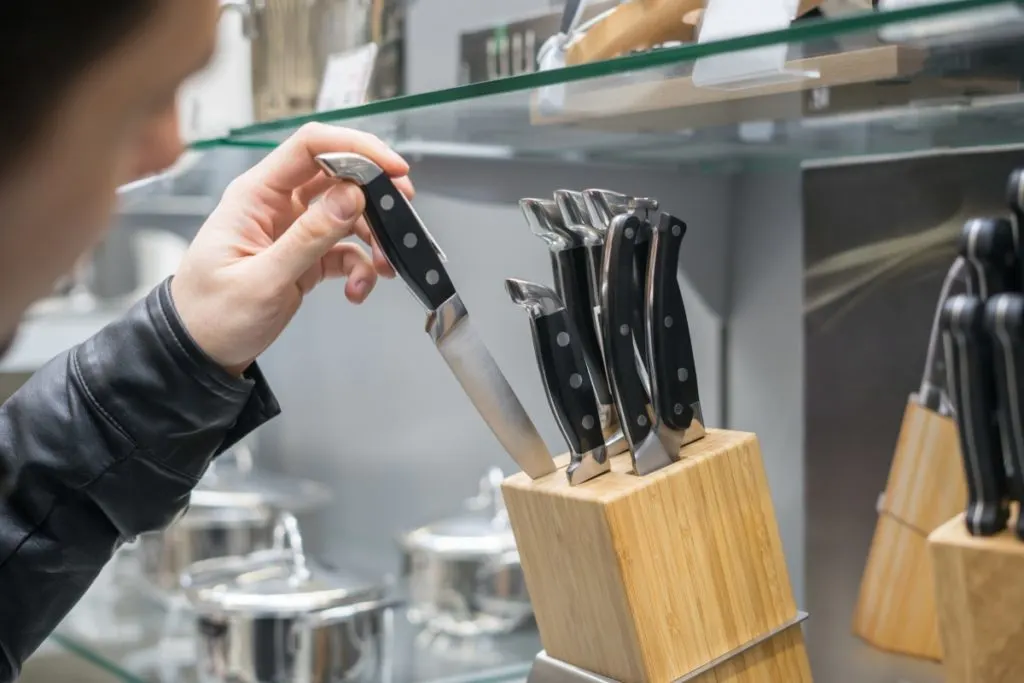
You should consider several aspects before deciding on a storage method for your knives. Not all the knife storage methods we will discuss will suit all situations. You should choose the best possible storage option that offers protection and safety for the knives and other people.
Some aspects you should think about before settling on a storage option should include the following.
- Storage that offers the best protection. Always choose the knife storage solution that offers the best protection for the knife and the knife user.
- The convenience of the storage option. If the storage option is not convenient to use and suitable for the space you have available for storage, you won’t use the storage method. This would be a waste of money and leave you with no storage option for your knives. The storage option should make it easy to retrieve the knives and pack them away when you are done.
- Ease of cleaning. Knife storage options need to be kept clean to prevent corrosion, bacteria and mold, and dirt build-up that could negatively affect your knives. Will cleaning be easy for your chosen knife storage option?
Take a look at the best place you have to store your knives safely, and then select the best option that matches your requirements.
Another aspect of knife storage that must be a top consideration is the state in which you store your knives. Knives must always be stored clean and dry!
Food and other remnants on the knife can harbor bacteria and encourage mold development in the knife storage method.
Moisture left on the knife when it is stored will promote corrosion and rust development, which is detrimental to the condition of your knife.
Always wash your knives and dry them thoroughly before packing them away, irrespective of the knife storage method you use.
TIP: It is a fairly recent trend for manufacturers to take left-handed people into account and start producing knives easier for these people to use. Find out more about left-handed knives in the article below:
Left-Handed Knives: How Do They Differ + Best Ones To Buy
Where Should I Store My Kitchen Knives
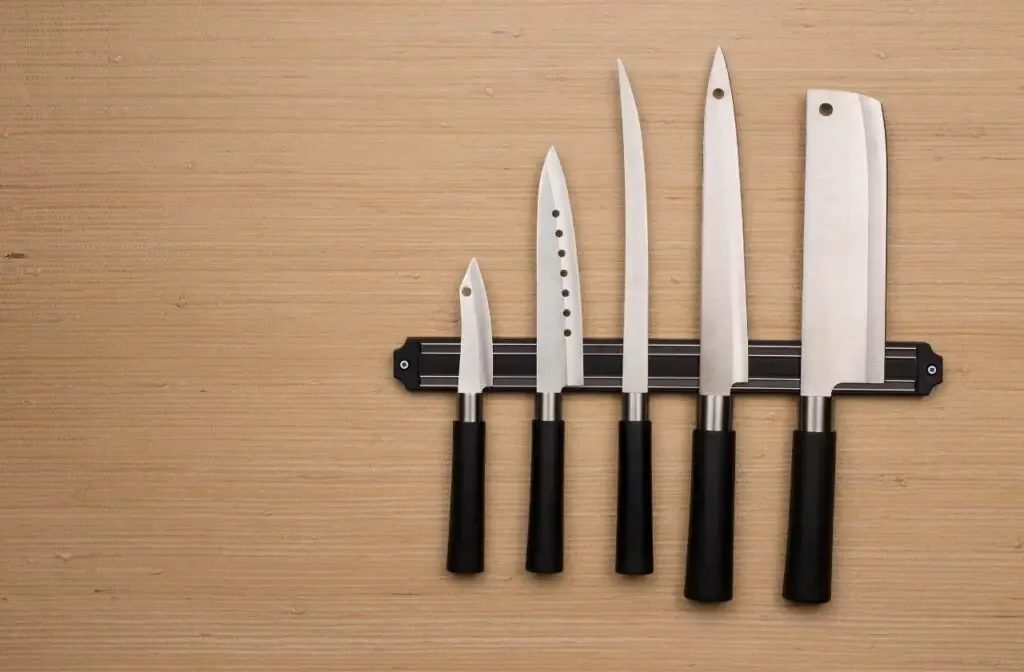
There are essentially three locations where you can store your knives, but each location can have various methods of storage.
The three places most people store their knives are either in a kitchen drawer, on the countertop, or mounted on a wall. Each location is a valid storage option as long as the storage method provides the best protection possible for the knife.
Countertop Knife Storage
Several reasons could make countertop storage of your knives the best option for you. Countertop storage offers the following advantages for knife storage.
- Makes use of unused space on your countertop. Countertop corners or spaces up against the wall are often unused spaces that can easily be used to store your knives.
- Convenient location. Storing knives on the countertop makes them readily accessible when you need them and quick to pack away after cleaning and drying the knives.
- Insufficient draw space. Lack of draw space in a kitchen may make an unused countertop space the best knife storage location.
Several countertop storage options are available, each with its own footprint, making it possible to find a suitable option even with limited space on the countertop.
One of the disadvantages of countertop storage is that you own a lot of knives. Most serious cooks will have a wide range of knives, and it would not be appropriate or sensible to keep all the knives in countertop storage.
In this case, countertop storage would be suitable for the knives you use the most, but then you would need an alternative method to store the balance of the knives in your collection.
Kitchen Drawer Knife Storage
A kitchen drawer is a good, safe place to store knives if you choose an appropriate in-drawer storage method to protect the knives from other items in the drawer. The chosen storage method should also protect people when they are reaching into the drawer to retrieve items.
Drawers make a good knife storage option for the following reasons.
- The knives are out of sight. When the knives are in the drawer, they are not only out of sight but also protected from being knocked off the counter and free up space on the countertop.
- Convenience. Retrieving and storing the knives in the drawer can be a simple task, depending on the in-drawer storage method selected. Some drawer storage methods are less convenient than others.
- Lots of drawer space. Some kitchens may have limited countertop space but plenty of drawer space. It is more efficient to use this drawer space for knife storage than to clutter up the countertop.
- Keeping knives away from children. Knives in drawers are generally safe from small children being able to get their hands on sharp knives.
- Keeps knives dust-free. Drawers add an additional layer of protection for the knives against dust and dirt in the kitchen. The drawer prevents dust from settling on the knives and on the storage method.
Drawer storage for your knives may be the best option for you, but you need to ensure your knives are adequately protected inside the drawer!
TIP: Buying knives for the kitchen can be an addictive and expensive habit, especially if you purchase kitchen knives without a plan! Check out all the kitchen knives you need to own in the article below:
You Need Exactly This Number Of Knives In The Kitchen + Why
Wall Storage For Knives
Wall-mounted knife storage is another popular method for safely storing knives, but care must be taken on the location of the storage and the quality of the storage method.
The wall-mounted storage should be in a location where people cannot knock the knives off the wall and where the knives will not be exposed to excessive moisture or other contaminants such as dust.
The following reasons make wall-mounted knife storage a viable option.
- Convenience. Convenience is probably the biggest factor in favor of wall-mounted knife storage. The knives are easy to retrieve and easy to replace in the storage position.
- Lack of other storage options. If other storage options are limited, wall-mounted knife storage done correctly can be a safe and secure knife storage method.
- Knives are used regularly. If you use your knives every day, wall-mounted options are a good choice for convenience and availability. If you do not use your knives often, wall-mounted storage is probably not the best storage method.
If wall-mounting your knives is a viable option, you must select a mounting method that will hold the knives in place securely and choose a mounting location that will prevent the knives from being bumped off but still be convenient to retrieve and replace the knives.
Another limitation of wall-mounted storage is the number of knives the method can accommodate.
Should Knives Be Stored Blade Up Or Down
The storage position of a knife should be taken into consideration, especially for knives with ultra-thin, sharp edges.
If a knife is stored resting on the cutting edge, the knife’s weight can cause the edge to roll or deform, which results in the knife becoming dull.
The weight of the knife can also stress the thin metal on the cutting edge, and it will develop micro-fractures over time, reducing the quality of the edge and requiring frequent sharpening.
If the knife is stored on its edge, there will be a tendency to drag the cutting edge over the material as it is extracted or replaced in storage. Depending on the material the storage method is made from, this action can dull the knife each time it is withdrawn or replaced.
Due to these potential issues with knife storage, you must consider the knife storage position when selecting your knife storage option. Limiting any pressure on the knife’s sharp edge will extend the interval between sharpening and help preserve the knife’s edge!
TIP: The concept of a self-sharpening knife sounds a little mysterious and magical, as if it is something that belongs in fiction rather than real life! Find out more about self-sharpening knives in the article below:
Self-Sharpening Knives: All You Need To Know About Them
How Should Knives Be Stored To Keep Sharp Edges?
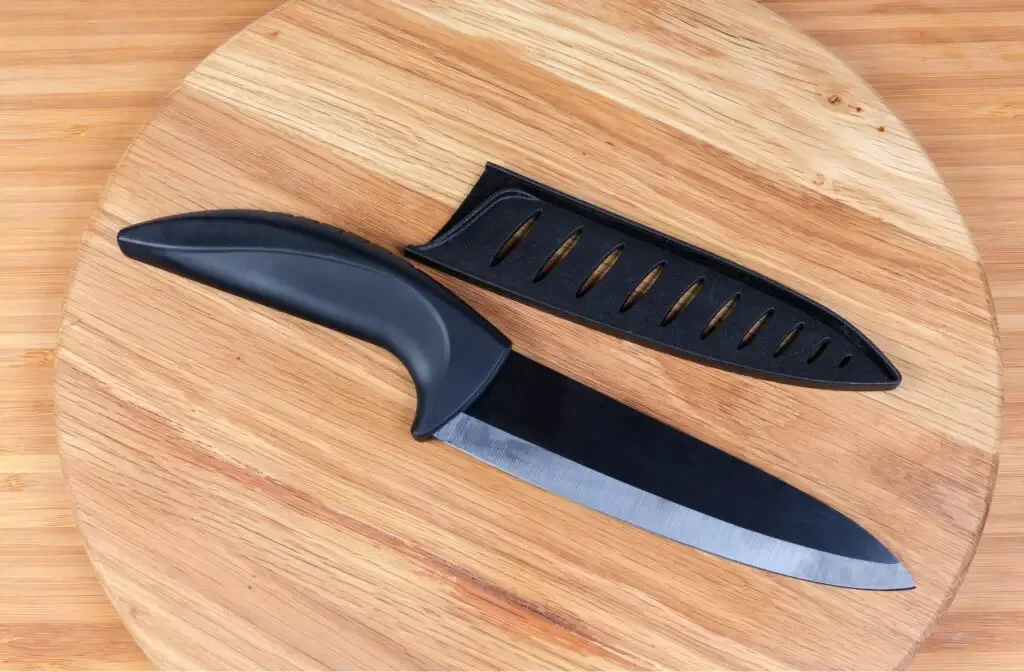
One of the primary goals of storing a knife correctly is to preserve the sharpness of the edge. There are several ways of achieving this in combination with your chosen method of knife storage.
Some storage methods inherently protect the knife’s sharp edge, but many other methods can benefit from additional edge protection.
The best storage methods to keep a knife sharp are the ones that prevent the sharp edge from coming into contact with hard surfaces or from sustaining impact damage from other knives or items stored with the knives.
Many knives are packaged with a plastic edge protector to protect the edge during packaging and shipping and prevent the knife from cutting anyone handling the packaged knife.
Do not throw this edge protector away when you unpackage your knife. It makes an excellent edge protector when storing your knife in a drawer or on a wall knife rack.
Is Bamboo Good For Knife Block
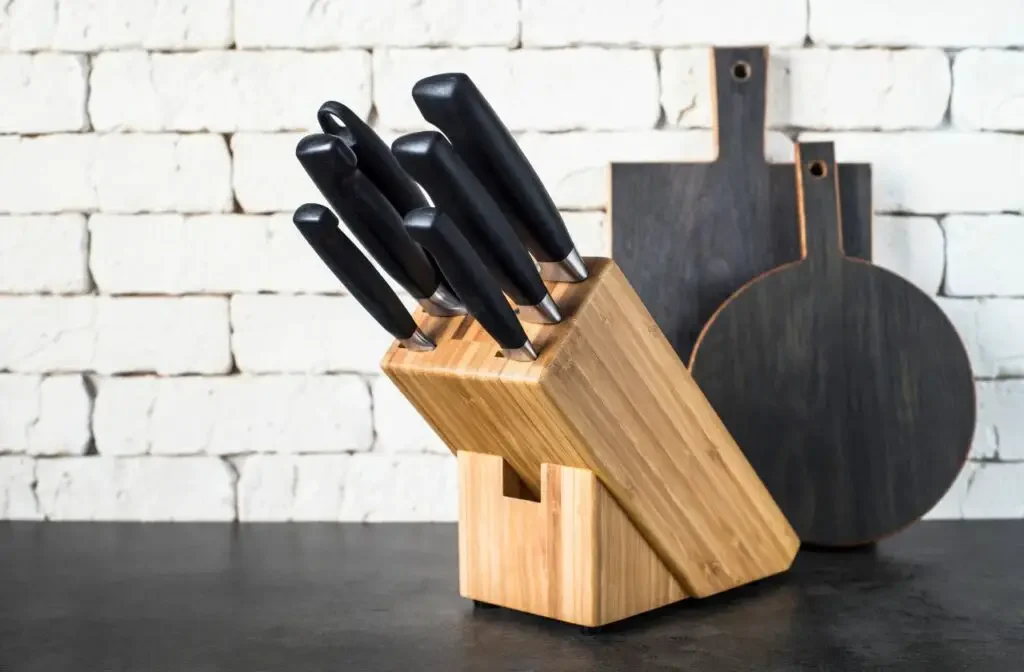
Bamboo is a common choice of material to make countertop knife blocks. Bamboo is a good material to use for this type of knife storage because it offers good protection to the blade and is resistant to moisture penetration.
The caveat to this is that the knife edge should not rest on the bamboo, and it should not be dragged across the bamboo surface when it is removed or replaced in storage.
Bamboo is a hard material that can potentially dull the knife’s edge if care is not taken to prevent unnecessary contact.
TIP: Bamboo and wooden cutting boards are popular with knife owners because they are knife-friendly and are made from natural products. Check out the cleaning guide in the article below:
4 Proven Methods: Cleaning Wooden & Bamboo Cutting Boards
Should Knives Be Stored In Drawers
Storing knives in drawers is an acceptable storage location and often the most practical storage for large numbers of knives.
If the drawer is your storage location of choice for your knives, you need to use an in-drawer storage method to protect the knives from other utensils in the draw and prevent accidental injury.
With the proper storage method for your knives in a drawer, it can be the safest option that provides the best protection for the knives.
BTW: If you want to know more about Japanese and other knives and their sharpening, check out the books listed above. These books are recommended by professional sharpeners and knife makers (Amazon links):
- Japanese Kitchen Knives: Essential Techniques and Recipes
- The Knifenerd Guide to Japanese Knives
- Knife: The Culture, Craft, and Cult of the Cook’s Knife
- Sharp: The Definitive Introduction to Knives, Sharpening, and Cutting Techniques, with Recipes from Great Chefs
How To Store Knives Long-Term
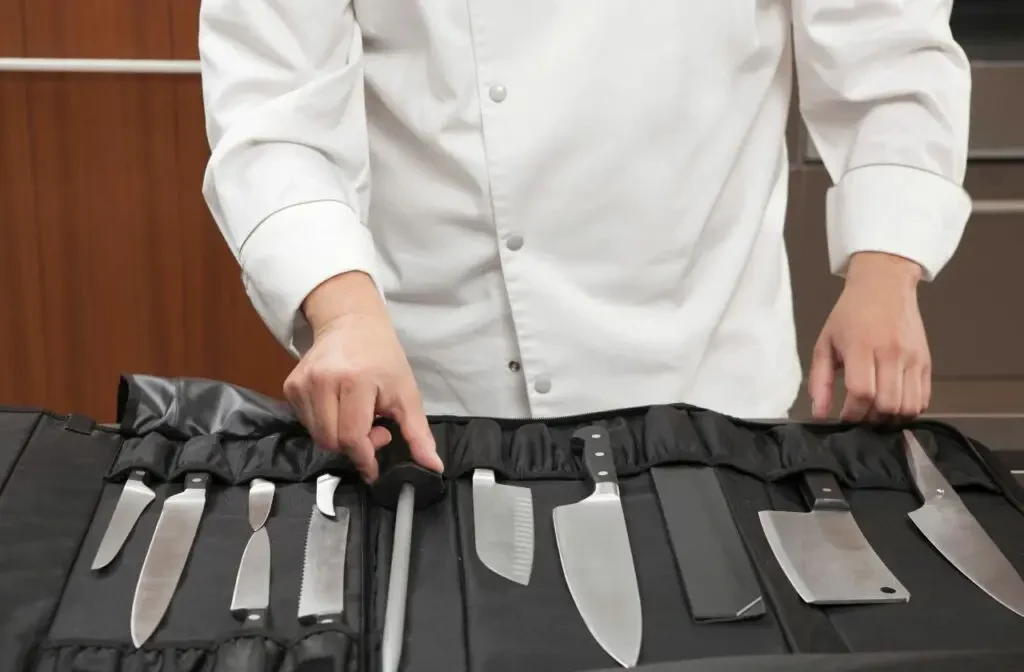
Knives that are not used often or that need to be stored long-term require some special treatment to keep them protected and secure.
One of the biggest risks for long-term knife storage is corrosion. This can occur naturally from the moisture present in the atmosphere or if the knife is exposed to humid or steamy conditions.
The best way to protect the knife for long-term storage is to give the blade a light coating of food-grade mineral oil and wrap the blade in a soft cotton cloth. The knife with the blade wrapped in the cloth can then be stored in a drawer or a box for a long period.
If your knife has a leather sheath, it is not advisable to store the knife in the sheath long-term. Leather sheaths will absorb moisture from the air and concentrate the moisture around the knife, leading to rust and stains on the knife.
Pro Knife Storage Tip – Adding a silica gel pack to the storage location will help reduce the moisture content near the knife. The silica gel pack will absorb excess moisture and help to prevent rust from developing on the steel.
TIP: Not only your knives but sharpening stones need to be stored properly too. Correct use and storage of your whetstones will contribute to protecting and preserving them. Find out more in the article below:
Buyer’s Guide: The Best Whetstone Holders & Storage Boxes
How To Organize Kitchen Knives: 5 Clever Ways
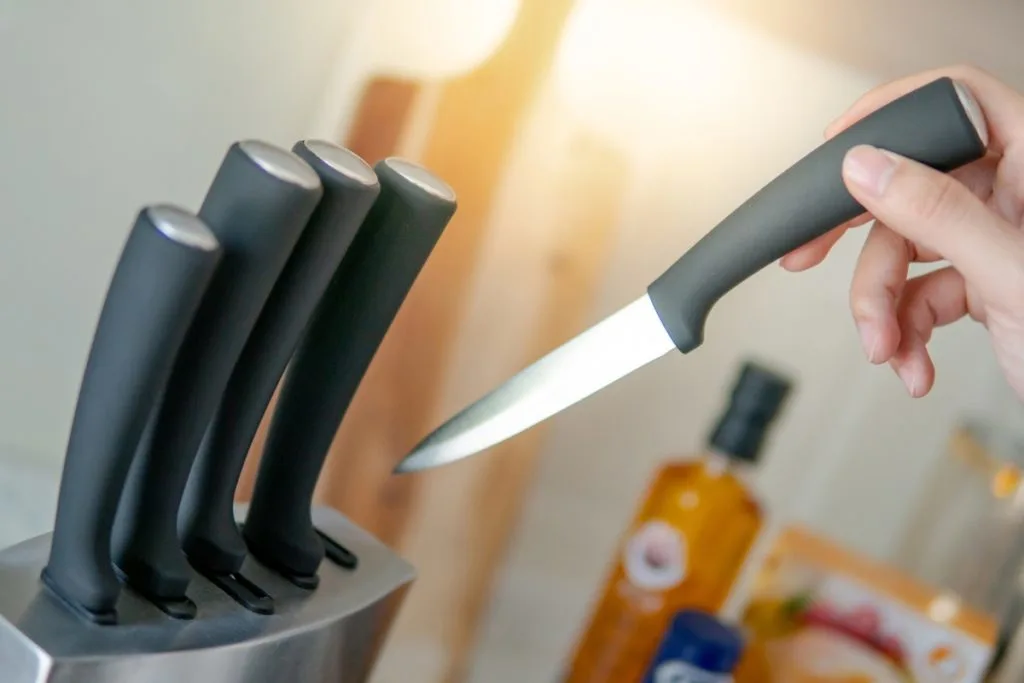
If you are still uncertain what would be the best way to store and organize your kitchen knives, we are ready to help you with some clever and novel ideas to safely store your knives.
We will discuss some countertop solutions, drawer storage options, and wall-mount knife storage ideas to give you some inspiration for your knife storage.
1. Bamboo Skewer Knife Block
The bamboo skewer knife block is an innovative idea for storing your knives on the countertop using bamboo skewers to support the knives in a container.
The ingenious aspect of this method is that the block does not have slots that will only fit knives of a certain size. Any size knife can be slipped into the bamboo skewers, and it will be held firmly in place.
You can make this type of knife storage at home with a few basic materials. A narrow, tall tin is ideal for the job and a few packets of bamboo skewers.
You may want to cut the sharp tips off one end of the bamboo skewers, but this is not a necessity for the skewers to work. The tin should be as tall as the bamboo skewers, so the tops of the skewers will be flush with the upper edge of the tin.
Pack the bamboo skewers vertically in the tin as tight as you can. Try placing a few knives on the top of the tin to see if the skewers hold them securely. If it is too tight on the knives, remove a few of the skewers to make a little more room and test again. If the fit is too loose to secure the knives in place, add a few more skewers to the tin to pack them tighter.
Commercial versions of this type of knife block can be purchased, such as the Mantello Bamboo Universal Knife Block (Amazon link), which uses tightly packed flex-rods made of plastic instead of the bamboo skewers in our example.
2. Magnetic Wallmount Knife Rack
Magnetic knife racks are convenient for storing knives in unused wall space. This method provides easy access to the knives but keeps them safely out of the way when they are not being used.
Metal magnetic knife racks are not desirable because the steel on the rack can scratch and mark the knife blade. The best magnetic wall mount knife racks are made of wood with magnets embedded near the surface of the rack under a thin wood veneer.
An example of the magnetic wood knife rack is the Walnut Magnetic Knife holder (Amazon link), which holds the knife securely with strong magnets embedded beneath the smooth wood surface.
Pro Knife Storage Hack – When placing a knife on a magnetic wall-mount rack, place the spine of the knife on the magnetic rack first, then rotate the cutting edge towards the rack. This method prevents the sharp edge from being snapped against the rack by the magnets and dulling the edge.
TIP: One way that many people store their knives is on a magnetic strip that is mounted to a wall to keep the knives stored safely. But is this good for your knives? Find out the answer in the article below:
Do Magnets Damage Knives? Here’s the Complete Answer
3. Magnetic Countertop Knife Stands
A magnetic knife stand is the perfect combination of a countertop knife block and a magnetic knife rack. This storage device is a stand, which can be made of wood, with magnets embedded in the wood surface.
The stand will remain on your countertop, but the knives are simply placed vertically against the stand, and the agents hold them in place.
There are a number of designs available, allowing you to choose the shape that best suits your available countertop space.
This Acacia Wood Double-Sided Magnetic Knife Stand (Amazon link) is slimline and can hold a surprising number of knives in a relatively small space!
4. In-Drawer Knife Blocks
There are many types of in-drawer knife blocks that provide a safe and secure method of storing a wide range of knives in a kitchen drawer.
Essentially, this method is a variation of the countertop knife block. It is a horizontal piece of wood or bamboo that will fit in the kitchen drawer. The wood or bamboo has slots of various lengths cut to accommodate the placement of the knife blades.
This Bamboo In-Drawer Knife Block (Amazon link) is a good example and can house up to 16 knives in the block, separating each knife and allowing easy retrieval and replacement of knives in the block.
Pro Knife Storage Hack – Choose an in-drawer knife block with deep enough slots to cover the entire blade. Turn the knife over in the slot and store it with the cutting edge facing up. This position will prevent the knife’s weight from dulling the blade when it rests on the sharp edge.
5. Wood Or Plastic Knife Sheaths
Another knife storage idea that gives you options in how the knife is stored is an individual sheath for each knife.
Many Japanese knives come with a wood sheath called a Saya, which is designed specifically for this purpose. The sheath allows the knife to be stored in a drawer along with other knives and utensils, with the blade protected from damage.
If you do not have a Saya for your knives, you can purchase individual knife sheaths or edge guards such as these Noble Knife Edge Guards (Amazon link) that come in a 10-piece set. The sheaths are made from plastic and lined with felt to protect the finish on your knives.
BTW: If you are interested in buying the best cutting board, you can find our recommendations below:
- The best overall: Virginia Kitchen Boys Cutting Board (Amazon link). This fantastic cutting board is made from sustainable walnut wood from the United States and brings almost perfect safety when cutting with your knives.
- Alternative: Yoshihiro Cutting Board (Amazon link). Professional traditional Japanese cutting board that chefs around the world use.
- Cheaper option: Shun Cultery Cutting Board (Amazon link). Another Japanese cutting board stands out, especially for its simplicity and affordable price.
Expanded Reviews of Knife Storage Solutions
When choosing the right knife storage solution, several factors such as space, safety, accessibility, and aesthetics play a crucial role.
Here’s a more detailed look at some popular options.
Magnetic Knife Strips
Magnetic strips are mounted on the wall and use magnets to hold knives in place.
Pros: They are incredibly space-efficient, offering easy access and visibility of your entire knife collection. They also add a modern touch to kitchen decor.
Cons: They require available wall space, and knives need to be carefully placed to avoid scratching or damage. Not recommended for ceramic knives as the magnetic pull can damage them.
Ideal For: Kitchens with small, or limited counter space and chefs who prioritize ease of access and visibility. Great for those who enjoy displaying their knife collection as part of the kitchen’s aesthetic.
Knife Blocks
Traditional knife blocks are countertop organizers with pre-sized slots for different knives.
Pros: Knife blocks are widely available in various designs to match kitchen decor. They offer a safe and secure way to store knives, protecting the blades from damage.
Cons: The pre-sized slots may not accommodate all types of knives, and the blocks can take up valuable counter space. Also, slots can harbor bacteria if not cleaned regularly.
Ideal For: Those who prefer a traditional and aesthetic method of storage. Best for kitchens with enough counter space and for chefs with a diverse range of knife sizes.
In-Drawer Knife Organizers
These are inserts placed inside drawers, providing slots or sections to securely store knives.
Pros: In-drawer organizers keep knives out of sight and neatly arranged, making them a safe option in homes with children. They also help in maximizing drawer space and organizing knives by size or type.
Cons: This method can consume considerable drawer space and offers less immediate visibility of knives compared to other methods.
Ideal For: Kitchens with ample drawer space and for individuals who prefer to keep knives out of sight for safety and aesthetic reasons.
Under-Cabinet Knife Storage
This storage type involves a pull-out or swing-down mechanism installed under cabinets.
Pros: It’s a great space-saver that keeps knives hidden and is accessible when needed. This type of storage is ideal for keeping knives out of reach of children.
Cons: Installation can be challenging, and it’s not suitable for all cabinet types. Knives stored this way are not as easily accessible as those on a magnetic strip or block.
Ideal For: Those with limited counter and wall space who prefer to keep knives concealed. Suitable for kitchens where safety and space optimization are priorities.
Magnetic Knife Blocks
These blocks combine the traditional block design with magnetic holders, often featuring an exposed magnetic side where knives stick vertically.
Pros: They offer the visual appeal of a traditional block with the added modern functionality of a magnetic strip. This option is visually striking and practical.
Cons: They tend to be more expensive than other options and require careful placement to avoid dulling or damaging the knives.
Ideal For: Those seeking a blend of traditional and modern aesthetics in their kitchen. Suitable for chefs who have a mix of frequently used knives and others that are used less often.
Each of these storage solutions comes with its own set of advantages and considerations. Your choice will depend on your kitchen’s layout, your knife collection, and your personal preferences in terms of safety, accessibility, and aesthetics.
Remember, the right storage not only keeps your knives in good condition but also adds to the functionality and style of your kitchen.
Conclusion
Kitchen knives can represent a significant investment, especially if you opt for top-quality knives. Even if you have a cheaper set of knives, protecting them properly will allow you to get the most use and functionality out of them.
Storing your knives correctly and safely will reduce sharpening frequency, lower the risk of damage, protect the knives from corrosion, and prevent accidental cuts in the kitchen from stored knives!
TIP: Kitchen knives are hard-working knives, requiring some care going into selecting the knives for your collection. Check out the detailed guide on how to choose the best kitchen knives in the article below:
Buyer’s Guide: How To Choose The Best Kitchen Knife For You

